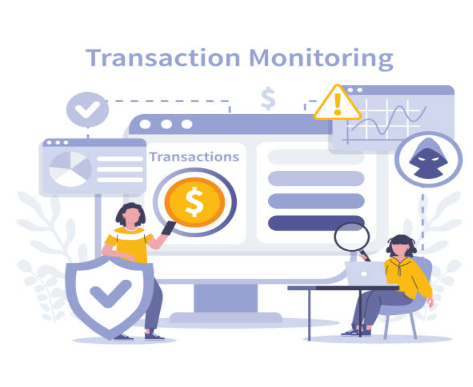Digital B2B platforms together with online marketplaces experience rapid growth as the modern digital economy accelerates. The B2B e-commerce market worldwide reached more than $7 trillion during 2023 and experts predict continuous market expansion according to data from Statista. The massive volume of transactions across various customer segments operating within digital B2B ecosystems has made financial crimes—particularly money laundering—a serious threat to the entire system. Transaction monitoring systems serve this purpose.
Transaction monitoring functions as a vital mechanism to spot and stop suspicious activities while they occur in real time. Early detection of irregularities stands as a critical factor to preserve compliance and customer trust for B2B platforms which handle payments across multiple countries with various currencies and third-party involvement.
The Basics: What Is Transaction Monitoring in AML?
Transaction monitoring within AML (Anti-Money Laundering) refers to the continuous process of examining customer financial activities. AML transaction monitoring represents a continuous operational method which evaluates client transactions made through deposits, withdrawals, transfers, and payments to notice potential criminal activity. Analyzed transactions must cover all operations that break sanctions regulations or show indications of fraud or assist money laundering schemes.
Business-to-Business marketplaces require unique Anti-Money Laundering transaction monitoring systems to detect trade-based money laundering and invoice misuse as well as shell company transactions and large or complex business payments. The implementation of transaction monitoring goes beyond being a best practice because regulators worldwide expect it as a standard requirement.
B2B Marketplaces Encounter More Advanced Anti-Money Laundering Risks Than Consumer Marketplaces
Complex Payment Structures
The payment processes in B2B transactions differ from those of consumer platforms because they lack simplicity. Business deals using staggered payment methods and letters of credit together with cross-border currency exchanges benefit from third-party financing. The intricate nature of financial transactions enables criminals to conceal illegal deals unless an enterprise implements thorough transaction monitoring.
Lack of Uniform Regulations
Many B2B platforms and online marketplaces have maintained operations without subjecting themselves to strict AML regulations throughout their historical development. But regulators are catching up. Non-traditional financial platforms must now prioritize AML transaction monitoring because the Bank Secrecy Act received updates and FinCEN began actively monitoring these platforms in the United States.
Red Flags in Transaction Monitoring for B2B Platforms
The warning signs for B2B environments have specific indicators per industry sector, yet they commonly feature:
- New businesses that pay abnormally high sums after completing their registration
- The system detects irregular invoice information due to vendor and value discrepancies
- Frequent round-dollar transfers across borders
- Companies face rapid increases in both transaction volume and frequency
- Operating in countries with high regulatory risks should be avoided unless the business needs a specific reason
Transactions monitored through the process can surface red flags which help organizations avoid both regulatory violations and harm to their reputation.
Real-Time Monitoring: A Competitive Advantage
More Than Just Compliance
AML transaction monitoring implementation has purposes that extend beyond satisfying regulatory requirements. A B2B platform benefits greatly from transaction monitoring as a strategic resource. The real-time monitoring system reveals comprehensive information about money movement through your system which lets you detect fraud and enhance payment processes while developing new product types according to user activity patterns.
Reducing False Positives
AML transaction monitoring faces a significant challenge because it must maintain both security and operational speed. Systems which generate an excessive number of false positive alerts will burden your compliance staff and alienate your valid users. The newest transaction monitoring systems implement behavior analytics together with machine learning to learn from historical patterns in order to minimize false positive alerts.
The Growing Need for Proactive AML Programs
Research by Deloitte in 2024 revealed that more than 40% of the operators working in fintech and digital marketplaces planned to strengthen their AML programs throughout 2024. U.S. regulatory agencies now demand marketplaces that facilitate payment transactions to establish monitoring systems which match those used by financial institutions.
U.S. authorities together with other regulators now understand that avoiding suspicious transaction indicators creates more than financial risk because it can result in heavy penalties or criminal prosecution under U.S. law.
Companies need to construct transaction monitoring systems that combine automated detection and manual evaluation for risk assessment.
Steps for B2B Platforms
- Risk Assessment
Businesses must determine which specific geographical areas, product types, and customer groups need increased examination. - Automated Monitoring Tools
The implementation of technological solutions should detect abnormal transactions in real-time systems with possible AI integration. - Regular Audits
The review process of your system for effectiveness and threat adaptation should be done regularly. - Staff Training
The operations staff, legal department, and support personnel must receive training about how to detect suspicious transactions and how to report them.
Your business will establish both compliance culture and regulatory adaptation through these implementation steps.
Future Trends of Anti-Money Laundering Approach in Business-to-Business Operations
B2B platforms have emerged from their previous position of silence regarding AML requirements. The expansion of digital business requires that the supporting financial systems develop along with it. Businesses operating today must implement smart adaptive transaction monitoring systems since U.S. regulators now show increased attention while global trade volumes rise alongside growing cybercrime threats.
Business protection against financial crime requires transaction monitoring to maintain integrity and sustainability as well as outpace potential threats. B2B platforms along with marketplaces must prioritize transaction monitoring because it serves as a business necessity in addition to being a regulatory mandate.










 /home/u448362301/domains/theexpotab.com/public_html/wp-content/themes/foxiz/templates/popup.php on line 167
/home/u448362301/domains/theexpotab.com/public_html/wp-content/themes/foxiz/templates/popup.php on line 167